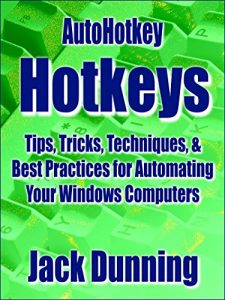Whether you're a noobie to AutoHotkey scripts or an advanced programmer, of all Jack's books, AutoHotkey Hotkeys may be the most important for little-known tricks and useful ideas. It's not that the other books don't cover significant features of AutoHotkey, but this book includes some of the most practical tips for adding power to your scripts.
Jack didn't plan it that way:
"In the course of writing the individual chapters I experienced a number of personal epiphanies. A few "Best Practices" slowly became obvious as I worked with particular commands. The power of #IfWin directives opened my eyes as I searched for practical applications for Hotkeys. The usefulness of Scan Codes versus Virtual keys became apparent once I understood how they work. Plus, the writing process sparked insight into how to make any AutoHotkey command more powerful with forced expressions (%) and the ternary operator."
The book starts at a beginning level (Chapter One), but it quickly builds upon the basic Hotkey structure to introduce more advanced techniques—including detailed discussions of the unique Hotkey command. Writing this book turned into a trip of discovery. Jack merely followed where the AutoHotkey commands and features led him.
AutoHotkey Hotkeys includes:
Chapter One Basic Hotkeys—The Gateway to AutoHotkey Script Writing Addiction
Chapter Two Block Windows Shortcuts with AutoHotkey
Chapter Three AutoHotkey #Directives for Context-Sensitive Hotkeys—#IfWinActive
Chapter Four The AutoHotkey GroupAdd Command Reduces Script Code
Chapter Five Exploring the Hotkey Command in AutoHotkey
Chapter Six Windows Volume Control Using Your Mouse Wheel and the AutoHotkey #If Directive
Chapter Seven Hotkeys for Deleting Words and Line Segments with AutoHotkey
Chapter Eight Toggling AutoHotkey Hotkeys On and Off
Chapter Nine AutoHotkey Windows Clipboard Techniques for Swapping Letters
Chapter Ten AutoHotkey StringSplit Command and ErrorLevel Tricks for Swapping Words
Chapter Eleven AutoHotkey Tips for Mouse Click Hotkeys with Seldom Touched Keys
Chapter Twelve Understanding AutoHotkey Keyboard Scan Codes and Virtual Key Codes
Chapter Thirteen AutoHotkey Scan Codes, Speech, Sound, and Splash Images in Children’s Apps
Chapter Fourteen When to Use Virtual Keys and Keyboard Scan Codes with AutoHotkey
Chapter Fifteen AutoHotkey Script for Precision Hotkey Mouse Movement in Windows Graphics Programs
Chapter Sixteen AutoHotkey Script for Precision Hotkey Mouse Movement in Windows Graphics Programs—MousePrecise.ahk Continued
Chapter Seventeen Force an Expression (%) in AutoHotkey for More Powerful Commands
Chapter Eighteen AutoHotkey Toggles and the Ternary Operator
Chapter Nineteen Tips for Smoothing Out AutoHotkey Scripts with #If, Tooltip, and Quick Release Hotkeys
Chapter Twenty Adding Hotkey Actions to Windows System Tray Icon Menu
Chapter Twenty-one Multiple Hotkeys and Using The Extra Mouse Buttons
Chapter Twenty-two Build Your Own AutoHotkey Command Reference Tool (An AutoHotkey Secret)
Curious about the contents of all the other ComputorEdge E-Books AutoHotkey offerings? Find a free download of all the Table of Contents and Indexes at the site.
Jack didn't plan it that way:
"In the course of writing the individual chapters I experienced a number of personal epiphanies. A few "Best Practices" slowly became obvious as I worked with particular commands. The power of #IfWin directives opened my eyes as I searched for practical applications for Hotkeys. The usefulness of Scan Codes versus Virtual keys became apparent once I understood how they work. Plus, the writing process sparked insight into how to make any AutoHotkey command more powerful with forced expressions (%) and the ternary operator."
The book starts at a beginning level (Chapter One), but it quickly builds upon the basic Hotkey structure to introduce more advanced techniques—including detailed discussions of the unique Hotkey command. Writing this book turned into a trip of discovery. Jack merely followed where the AutoHotkey commands and features led him.
AutoHotkey Hotkeys includes:
Chapter One Basic Hotkeys—The Gateway to AutoHotkey Script Writing Addiction
Chapter Two Block Windows Shortcuts with AutoHotkey
Chapter Three AutoHotkey #Directives for Context-Sensitive Hotkeys—#IfWinActive
Chapter Four The AutoHotkey GroupAdd Command Reduces Script Code
Chapter Five Exploring the Hotkey Command in AutoHotkey
Chapter Six Windows Volume Control Using Your Mouse Wheel and the AutoHotkey #If Directive
Chapter Seven Hotkeys for Deleting Words and Line Segments with AutoHotkey
Chapter Eight Toggling AutoHotkey Hotkeys On and Off
Chapter Nine AutoHotkey Windows Clipboard Techniques for Swapping Letters
Chapter Ten AutoHotkey StringSplit Command and ErrorLevel Tricks for Swapping Words
Chapter Eleven AutoHotkey Tips for Mouse Click Hotkeys with Seldom Touched Keys
Chapter Twelve Understanding AutoHotkey Keyboard Scan Codes and Virtual Key Codes
Chapter Thirteen AutoHotkey Scan Codes, Speech, Sound, and Splash Images in Children’s Apps
Chapter Fourteen When to Use Virtual Keys and Keyboard Scan Codes with AutoHotkey
Chapter Fifteen AutoHotkey Script for Precision Hotkey Mouse Movement in Windows Graphics Programs
Chapter Sixteen AutoHotkey Script for Precision Hotkey Mouse Movement in Windows Graphics Programs—MousePrecise.ahk Continued
Chapter Seventeen Force an Expression (%) in AutoHotkey for More Powerful Commands
Chapter Eighteen AutoHotkey Toggles and the Ternary Operator
Chapter Nineteen Tips for Smoothing Out AutoHotkey Scripts with #If, Tooltip, and Quick Release Hotkeys
Chapter Twenty Adding Hotkey Actions to Windows System Tray Icon Menu
Chapter Twenty-one Multiple Hotkeys and Using The Extra Mouse Buttons
Chapter Twenty-two Build Your Own AutoHotkey Command Reference Tool (An AutoHotkey Secret)
Curious about the contents of all the other ComputorEdge E-Books AutoHotkey offerings? Find a free download of all the Table of Contents and Indexes at the site.



